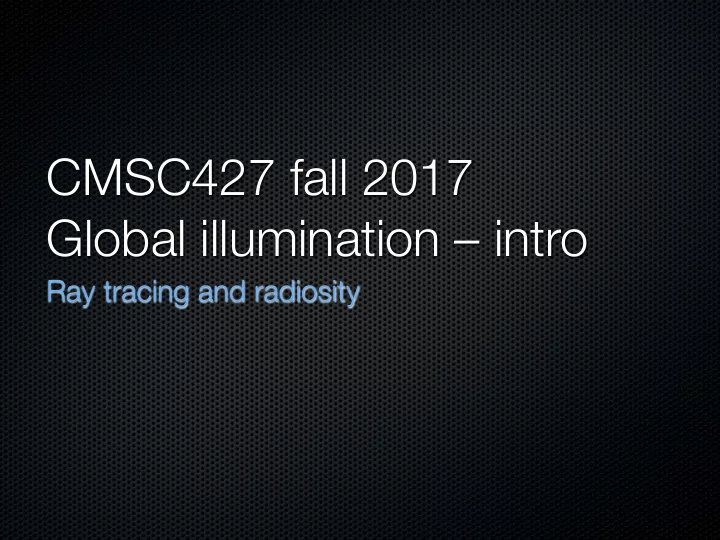

CMSC427 fall 2017 Global illumination – intro Ray tracing and radiosity
So far – local illumination One triangle, one light at a time Object rendering into image – what pixel sees me? Opaque surfaces No shadows, no crosstalk between facets
Now– global illumination + Scene oriented – consider all triangles and lights Image oriented rendering – what object can pixel see? Translucent and transparent surfaces, refraction Shadows, color bleeding
Ray Tracing and Radiosity General concepts What advantages do they have? How can you spot a ray-traced or radiositied image? How they work Ray tracing overview Radiosity overview Other approaches: path tracing, ray marching
Ray tracing Reflections, refractions Sharp shadows Partial physical model Point lights Tracing single rays
Radiosity Soft shadows Better physics Extended lights Integrating over extended areas
Ray tracing principles ç
The Rays Concepts: View (primary) ray Secondary rays Shadow ray (to all lights) Reflection ray Refraction ray
The rays again
Recursive rays (rinse, repeat)
Refraction Depends on ratio of speed of light between two materials
Tweaking ray tracing One is not enough One primary ray can “barely” miss an object Stochastic or random ray tracing multiple, random primary rays out of a pixel Speeding it up Speed up intersection calculations by data structure
Radiosity principles Global vs. local computations
The Cornell box
Radiosity vs. ray tracing Ray tracing - sample rays for each light, reflection and refraction Radiosity - integration over all rays on patch Iterate until light solutions are stable
Patch computations
Ray tracing details • The basic recursive algorithm • Casting the primary ray • Intersecting with an object: sphere (circle), triangle • Computing refraction ray
Ray tracing algorithm for (int j = 0; j < imageHeight; ++j) { for (int i = 0; i < imageWidth; ++i) { Ray primaryRay = new Ray(i,j); color[i][j] = rayTrace(primaryRay,0); }} rayTrace(ray, generation) if (generation > maxGen) return backgrdColor; hitPt = intersect(ray, objectList); if (hitPt == null) return backgroundColor; c = accumulateLights(hitPt); if (reflective(hitPt)) { reflectRay = reflect(ray,hitPt) c += trace(reflectRay) } if (refractive(hitPt)) { refractRay = refract(ray,hitPt) c += trace(refractRay) } return c
Casting first ray with t in [0,inf] 𝒒 𝒖 = 𝒇𝒛𝒇 + 𝒖(𝒋𝒏𝒃𝒉𝒇𝑸𝒖 − 𝒇𝒛𝒇) imagePt is (x‘,y‘,-d), eye is at origin
Intersecting with first object For each object: Compute hit time t when ray hits object Find object with smallest t – that is hit point Spheres are easiest!
Reflection & refraction
Refraction http://en.wikipedia.org/wiki/Refraction • Light rays that travel from one medium to an other are bent • To the viewer, object at location x appears to be at location y air water
Index of refraction http://en.wikipedia.org/wiki/Refractive_index • Speed of light depends on medium • Speed of light in vacuum c • Speed of light in medium v • Index of refraction n=c/v air • Air 1.00029 • Water 1.33 • Acrylic glass 1.49 • “Change in phase velocity leads to bending of light rays” water
Snell’s law http://en.wikipedia.org/wiki/Snell's_law • Ratio of sines of angle of incidence q 1 and refraction q 2 is equal to opposite ratio of indices of refraction n 1 , n 2 • Vector form in 3D • Viewing, refracted direction v, r (P,Q) • Normal vector n
Total internal reflection http://en.wikipedia.org/wiki/Total_internal_reflection • Angle of refracted ray • Critical angle • If we get , refracted ray is parallel to interface • If we have total internal reflection (light ray does not cross interface between media)
Fresnel equations • Fresnel equations are relatively complex to evaluate • In graphics, often use Schlick’s approximation https://en.wikipedia.org/wiki/Schlick%27s_approximation • Ratio F between reflected and refracted light • Indices of refraction n 1 , n 2
Newer algorithms • Path tracing • A multisampled, randomized version of ray tracing to approx. radiosity • Ray marching • A “binary search” approach to finding the hit point for complex shapes when no closed form exists
This image is …?
Recommend
More recommend